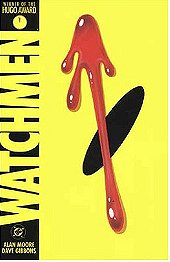I first read Watchmen when it was originally released in monthly installments, consisting of 12 issues back in 1986/87, and it blew my mind. I eagerly awaited each issue like I never had any comic before. At the time, I had pretty much given up on superhero comics and mainstream publishers like Marvel and DC, in favor of independent publishers. However, all that changed when I read Alan Moore's Watchmen. He injected reality, social commentary, and humanity (at it's best and worst) into the stagnant superhero market, at a time when DC and Marvel Comics' superheroes were becoming stale and redundant (at least in my opinion). I think Moore realized this too and decided to deconstruct the superhero myth. In the alternate history world of Watchmen, costumed vigilantes have been replaced with government-sanctioned "superheroes", who all share a rather bleak and nihilistic view of their world which perfectly reflected the tension, fear and paranoia of Reaganite America. The threat of nuclear armageddon was a very real possibility. After all, there are no real "supervillains" left in the world of Watchmen, so the only people they have to struggle with is society and themselves. The flow and structure of the non-linear plotline was also groundbreaking at the time (as far as comics were concerned). Now let's talk about the art. Who could ever forget the blood-stained smiley, a truly iconic image, which appears and reappears strategically throughout the story, along with other minute visual details and symbols that add to the plot. The combination of Dave Gibbons' artwork with John Higgins' colors was perfect, creating a natural flow with Moore's story. The art is rich and detailed, yet simple enough not to overload the brain with TOO much visual stimulation. So it does what truly good comic book art should do - aid the reader's enjoyment of the story, rather than overpowering it. And what a superbly crafted story it is. Of course, there are those who read superhero stories purely for escapism and don't appreciate reality slapping them in the face when they read a comic book. But as far as I'm concerned, writers like Alan Moore, Frank Miller and Neil Gaiman were the greatest thing to happen to the mainstream comic market. They brought forth serious, darker, and more realistic stories; but more importantly the skill with which they crafted the stories and adapted them to comic book/graphic novel format insured they would be read, re-read, and reprinted for generations to come. It was largely thanks to the 1987 graphic novel collection of Watchmen, along with Frank Miller's Batman: The Dark Knight Returns the previous year, which really brought the graphic novel format forward, for better or worse. And I say "for better or worse" because the downside of this is that nowadays any comic book publisher can throw together a collection of crap in a trade paperback format, release it as a "graphic novel", and it somehow becomes more acceptable and commercially viable. But I digress, the above statement has nothing to do with Watchmen, which is pure gold, and should be purchased by anyone who enjoys a good story that really engages the reader!
10/10
 Login
Login